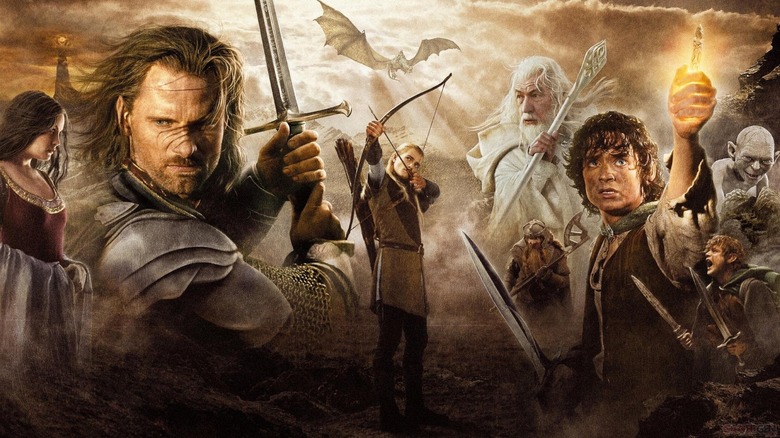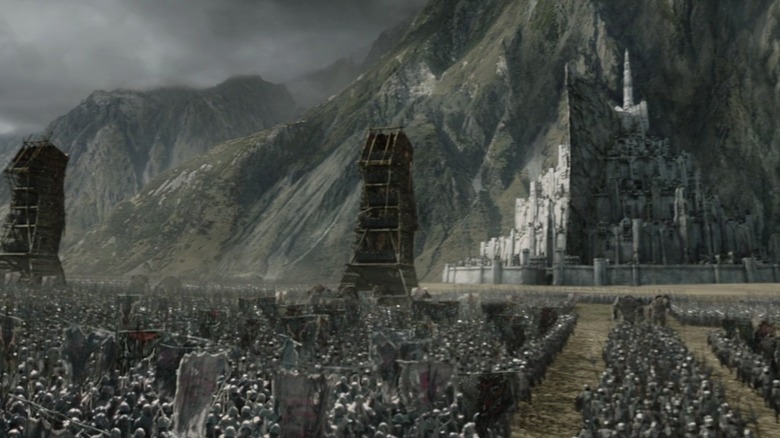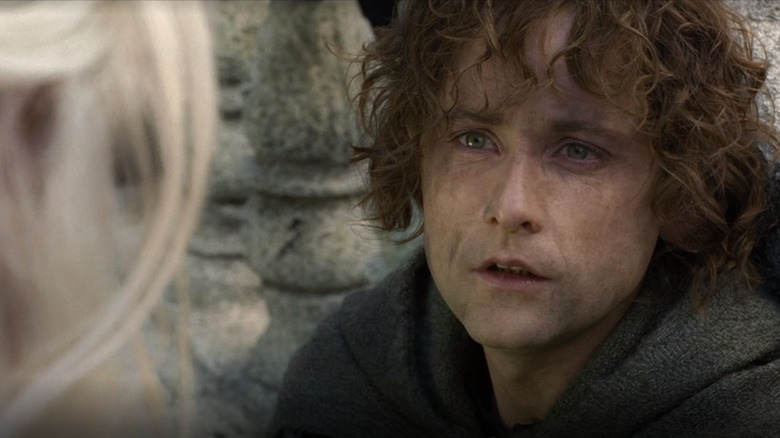The Siege Of Gondor In The Lord Of The Rings: The Return Of The King Is The Best Action Scene Ever
(Welcome to Best Action Scene Ever, a column dedicated to breaking down the best, most effective action sequences throughout the genre. In this edition, we revisit the last time a crowd-pleasing, action-heavy genre film swept the Academy Awards with "The Lord of the Rings: The Return of the King.")
I'm not breaking any new ground here by pointing out that, traditionally, action movies haven't fared all that well at the Academy Awards. When "Mad Max: Fury Road," arguably the greatest of all time, could handily win most of the technical, below-the-line awards but be denied any of the more "prestigious" honors back in 2016, well, that kind of says it all. The fully-ingrained genre bias within the voting body might finally have started to melt away in recent history, as evidenced by "Everything Everywhere All At Once" and its delightfully strong performance at this year's awards, but certain films managed to break through even before the cultural tide began to turn. In 2004, one film truly ruled them all with a whopping eleven nominations and wins — despite featuring Hobbits, wizards, and an approximately 50-minute-long battle sequence.
With the surprisingly good 2023 Oscars ceremony now in the rearview mirror, it's time to look back at "The Lord of the Rings: The Return of the King" and, specifically, the extended Siege of Gondor sequence that blew audiences away upon release. Movies like "Avatar" or "Avengers: Endgame" have attempted to recapture the same magic in the decades since, but none have managed to top the high water mark for depicting action on an epic, blockbuster scale. Here's why.
The scene
Let's put it this way: For director Peter Jackson and co-writers Fran Walsh and Philippa Boyens, there was no margin for error in portraying the battle that was an entire trilogy in the making. Even the prolifically anti-war author J.R.R. Tolkien — who had never hesitated to gloss over and cut away from scenes of war and carnage on multiple occasions throughout both "The Hobbit" and "The Lord of the Rings" novels — couldn't help but devote six entire chapters to the most significant turning point in the War of the Ring. The stakes, both narratively and otherwise, had never been higher.
Armed only with the knowledge that the all-powerful One Ring is in the hands of a Hobbit, the villainous Sauron makes his boldest and most aggressive move yet against the realm of Gondor. The greatest battle in the Third Age of Middle-earth would take place in and around the city of Minas Tirith, one of the last major strongholds still standing against the might of Mordor. Having inadvertently received a glimpse of Sauron's plans, Gandalf (Ian McKellan) and his troublesome ward Pippin (Billy Boyd) make a beeline for the city to warn them of the impending threat. But handcuffed by the shoddy leadership of the cynical and grief-stricken Steward Denethor (John Noble), mourning the loss of his son and member of the Fellowship Boromir, it almost seems as if the enemy's plans have been halfway accomplished already.
The attack commences with some of the nastiest imagery pulled straight from Tolkien's text, as hundreds of decapitated heads are catapulted into Minas Tirith. But finally spurred into action by the depths of Denethor's despair, Gandalf takes charge of the city's last defense and joins the battle in earnest.
Why it works
How many blockbusters can you think of that have made the mistake of throwing as much at audiences as possible as a shortcut to crafting an effective set piece? Logistically, it's nothing short of a miracle that the entire middle acts of "The Return of the King" don't feel like an unbearable, mind-numbing slog. Similar to the slow build leading up to the Battle of Helm's Deep in "The Two Towers," the creative team waits until the movie hits the hour-and-a-half mark (and over 2 hours in the extended edition!) to ramp up the action ... and it rarely eases off the gas pedal again.
But once the fight begins and the scope of the battle becomes clear, it's important to note that the film never loses sight of why we're invested in the first place. The truth of the matter is that not even the most jaw-dropping visual effects, the most imaginative action sequences, or all the exorbitant budgets in the world could ever replace the heart and soul of the picture.
As the scope and scale steadily increase, "The Return of the King" somehow balances that out by focusing more and more intimately on the individual heroes caught up in the midst of the larger-than-life spectacle. We don't really care about Minas Tirith being razed to the ground, but only about Gandalf and Pippin's well-being. The last-minute appearance of the Rohirrim plays like gangbusters, but mostly because the triumphal turn gives Merry (Dominic Monaghan) and Éowyn (Miranda Otto) their long-deserved hero moments. All throughout the battle's ebbs and flows, we repeatedly return to our main characters and how they're affected by such dire circumstances.
Expertly crafted with a series of miniature narrative arcs, the action during the Siege of Gondor is all about the characters.
The key moment
One of the many reasons "The Return of the King" manages to stand the test of time is that this entire sequence of the film is filled with peaks and valleys. The doom and gloom cast by Denethor immediately makes the situation seem hopeless for the good guys. Thanks in large part to director of photography Andrew Lesnie's painterly eye, the overwhelming advantage of Sauron's forces is constantly framed for maximum impact. (Think of the moment when Denethor falls to his death in one of the most eye-popping visuals of the entire film.) Even the exhilaration of Théoden's reinforcements is tempered almost immediately by the arrival of the Haradrim warriors atop their war elephants, the massive Mûmakil.
Everywhere we turn, brief flashes of victory are followed by the noose tightening ever tighter around the necks of our heroes.
And nowhere does the whiplash of emotions hit harder than when Gandalf and Pippin, boxed into a literal corner in a tiny room as Minas Tirith is all but overrun by the orcs, contemplate their impending deaths. Few movies these days would ever take the time away from the bigger battle raging outside to zero in on questions of mortality and the afterlife, but Jackson, Walsh, and Boyens' script boldly stops the movie in its tracks to let this one quiet moment breathe for as long as it needs. Gandalf's monologue about the "far green country" he glimpsed during his previous brush with death provides a bittersweet and melancholy respite for our weary Hobbit, overwhelmed by as traumatic an event as he could've ever imagined.
At its lowest possible moment, "The Return of the King" sums up the entire trilogy's ethos and reminds us that there's still hope ... even at the darkest of times.


